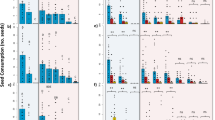Abstract
When the alfalfa [Bruchophagus roddi (Gussakovsky)], clover [Bruchophagus gibbus (Boheman)], and trefoil seed chaldds (TSC) [Bruchophagus platypterus (Walker)] were exposed to yellow, white, green, and purple painted polyethylene vials perforated by four small holes, only the latter species had a color preference, and that was for yellow, the color of its host flower. When TSC were exposed to green and yellow targets 5 h after sunrise, they preferred yellow targets but not 1 h after sunrise. The possibility of a circadian response was eliminated because different sequences of light-dark regimes prior to the test did not change the results. When TSC were exposed only to yellow targets, half of which had trefoil flowers hidden within, females preferred targets with flowers. When an identical test was conducted but with green instead of yellow targets, the preference for targets with flowers disappeared. In a four-choice test, TSC preferred yellow targets with or without flowers to green targets with or without flowers. Thus, TSC displayed an olfactory response only when the color yellow was present. In unfiltered skylight females preferred baited targets when the test began 3 h before or 1 h after solar noon but not 4 h before or 2 h after solar noon. Chalcids did display an olfactory preference 4 h before solar noon when a Polaroid filter was used to filter skylight and provide an east-west but not a north-south E-vector. When Helmholtz coils were used to apply a magnetic field that canceled or changed the direction of the earth's magnetic field, olfactory preference disappeared because the applied magnetic field changed TSC perception of the E-vector. In effect, TSC must perceive yellow in the presence of an east-west E-vector to display an olfactory preference to a choice of odors. We believe this is the first report that the E-vector of celestial light can influence olfactory and visual behavior of an insect.
Similar content being viewed by others
References
Brines, M. L. (1980). Dynamic patterns of skylight polarization as clock and compass.J. Theor. Blol. 86: 507–512.
Brines, M. L., and Gould, J. L. (1982). Skylight polarization patterns and animal orientation.J. Exp. Biol. 96: 69–91.
Burks, B. D. (1957). A newBruchophagus from a Liliaceous plant with a host plant list for the genus.Proc. Entomol. Soc. Wash. 59: 273–277.
Carrillo, J. L., and Dickason, E. A. (1963). Biology and economic importance of seed chalcids infesting red clover and alfalfa in Oregon.Oreg. Agr. Exp. Stat. Tech. Bull.68.
De Jong, D. (1982). Orientation of comb building by honey bees.J. Comp. Physiol. 147: 495–501.
Duncan, G. A., and Walker, J. N. (1975). Selection of greenhouse covering materials.Trans. ASAE 18: 703–706.
Godbey, L. C., Bond, T. E., and Zornig, H. F. (1979). Transmission of solar and long-wavelength energy by materials used as covers for solar collectors and greenhouses.Trans. ASAE 22: 1137–1144.
Hale, L. D., and Fronk, W. D. (1967). Reactions of alfalfa seed chalcid,Bruchophagus roddi, to light (Hymenoptera: Eurytomidae).Ann. Entomol. Soc. Am. 60: 431–434.
Kamm, J. A. (1989). In-flight assessment of host and nonhost odors by alfalfa seed chalcid (Hymenoptera: Eurytomidae).Environ. Entomol. 18: 56–60.
Kamm, J. A. (1990). Control of olfactory-induced behavior in alfalfa seed chalcid (Hymenoptera: Eurytomidae) by celestial light.J. Chem. Ecol. 16: 291–300.
Kamm, J. A., and Buttery, R. G. (1986). Response of the alfalfa and clover seed chalcids (Hymenoptera: Eurytomidae) to host plant components.Environ. Entomol. 15: 1244–1249.
Kevan, P. G., and Baker, H. G. (1983). Insects as flower visitors and pollinators.Annu. Rev. Entomol. 28: 407–153.
Kolobova, A. N. (1950). The clover and alfalfa races of the seed pestBruchophagus gibbus (Boh.).Entomol. Obozr. 31: 63–70.
Kugler, H. (1943). Hummeln als Blutenbesucher.Ergeh. Blol. 19: 143–323.
Lindauer, M. (1971).Communication Among Social Bees, Harvard University Press, Cambridge, Mass.
Menzel, R. (1975). Color receptors in insects. In Horridge, G. H. (ed.),The Compound Eye and Vision of Insects, Oxford University Press, Ely House, London, pp. 121–153.
Miller, J. R., and Strickler, J. L. (1984). Finding and accepting host plants, In Bell, W. J., and Cardé, R. T. (eds.),Chemical Ecology of Insects, Sinauer Associates, Sunderland, Mass., pp. 127–157.
Phillips J. B., and Waldvogel, J. A. (1988). Celestial polarized light patterns as a calibration reference for sun compass of homing pigeons.J. Theor. Biol. 131: 55–67.
Prokopy, R. J., and Owens, E. D. (1983). Visual detection of plants by herbivorous insects.Amu. Rev. Entomol. 28: 337–364.
Rossel, S. (1989). Polarization sensitivity in compound eyes. In Stavenga, D. G., and Hardie, R. C. (eds.),Facets of Vision, Springer-Verlag, Berlin, Heidelberg.
Strong, F. E., Bacon, O. C., and Russell, J. R. (1963). Flight habits of the alfalfa seed chalcid,Bruchophagus roddi Guss. (Hymenoptera: Eurytomidae).Hilgardia 35: 1–12.
Walker, M. M., and Bitterman, M. E. (1989). Conditioning analysis of magnetorception in honeybees.Bioelectromagnetics 10: 261–295.
Waterman, T. H. (1989).Animal Navigation, Scientific American Books, New York.
Wehner, R. (1976). Polarized-light navigation by insects.Sci. Am. 235: 106–115.
Wehner, R., and Rossel, S. (1985). The bee's celestial compass—a case study in behavioral neurobiology. In Hölldobler, B., and Lindauer, M. (eds.),Experimental Behavioral Ecology and Sociobiolgy, Sinauer Associates, Sunderland, Mass., pp. 11–53.
Wipfli, M. S., Wedberg, J. L., Hogg, D. B., and Syverud, T. D. (1989). Insect pests associated with birdsfoot trefoil,Lotus corniculatus, in Wisconsin.Great Lakes Entomol. 22: 25–33.
Author information
Authors and Affiliations
Rights and permissions
About this article
Cite this article
Kamm, J.A., Fairchild, C.E., Gavin, W.E. et al. Influence of celestial light on visual and olfactory behavior of seed chalcids (Hymenoptera: Eurytomidae). J Insect Behav 5, 273–287 (1992). https://doi.org/10.1007/BF01049294
Accepted:
Issue Date:
DOI: https://doi.org/10.1007/BF01049294




